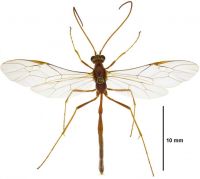ICHNEUMONIDAE: : Degithina Cameron 1901
Diagnosis:
Characteristics of Degithina include: 1. Body size mostly <10mm, but some ~15mm; 2. Position of spiracle on T1 clearly behind the centre; 3. Shape of aerolet in forewing pentagonal (closed); 4. Colour of face various; 5. Metasoma compressed dorsal-ventrally; 6. Size of ocelli small; 7. Length of antennae shorter than body; 8. Length of ovipositor barely visibale to distinct but not longer than body; 9. Wings present; 10. Colour of wings hyaline (clear), very rarley darkened; 11. Sternaulus absent to short; less than 0.5x length mesopleuron; 12. Shape of face in lateral view is flat or only weakly bulging; 13. Sternite on T1 (viewed laterally) not extending past spiracle; 14. Shape of T1 (viewed laterally) humped, often very pointed; 15. Number of teeth in mandibles 2; 16. Patterns on metasoma variable; 17. Length of T1 vs T2 subequal in length; 18. Sculpture on mesoscutum smooth, very polished or finely pitted, many hairs; 19. Width of T1 (viewed dorsally) anterior part slender often parallel, strongly widening behind spiracle; 20. Glymma on T1 absent; 21. Sculpture on metasoma smooth with a semi-glossy or satin appearance at least on T2; 22. Propodeum reaching past coxal insertion, but not reaching halfway along metacoxae.Similarity to Other Taxa
Degithina are large-medium sized Ichneumonids in New Zealand. They are similar in size to: Rhyssa , Lissopimpla , Echthromorpha , Ophion (1 species), Enicospilus , Eutanyacra , Ichneumon, Netelia , Ctenochares .They are most similar to Eutanyacra , Ichneumon , and also Aucklandella (who are smaller <10mm). Degithina can generally be seperated from these by having its T1 very humped (pointed, bulge).Compare
-

Ctenochares
Has distinct colourations in the forewing, which Xanthocryptus does not have. -

Lissopimpla
Has distinct colourations in the forewing, which Xanthocryptus does not have. -

Echthromorpha
Has distinct colourations in the forewing, which Xanthocryptus does not have. -

Enicospilus
Has large distinct ocelli, which Xanthocryptus does not have. -

Ophion
Has large distinct ocelli, which Xanthocryptus does not have. -

Netelia
Has large distinct ocelli, which Xanthocryptus does not have.
Distribution in NZ
North Island: ND, AK, BP, CL, HB, TK, TO, WN, WO. South Island: NN, NC, SD, BR, MB, MC, DN, CO, OL, WD, FD, SI, MK, SL. Offshore Islands: CH.
Species in NZ
An endemic genus with approximately twenty four species, including nine described: Degithina actista (Cameron 1898); D. apicalis (Ashmead 1890); D. davidi Cameron 1901; D. decepta (Smith 1876); D. exhilarata (Smith 1876); D. hersilia (Cameron 1898); D. huttonii (Kirby 1881); D. melanopus (Cameron 1901); D. sollicitoria (Fabricius 1775).Biology & hosts
This endemic genus is found throughout New Zealand but not caught in large numbers. Degithina are large, brightly coloured and patterned (yellow, red, black). Little is known about their biology, although they are all thought to be parasitoids of Lepidoptera larvae or pupae.Host records include: Degithina exhilarata from the Common Forest Looper, Pseudocoremia suavis (Geometridae); Degithina decepta from Wiseana cervinata , and W. umbraculata (Hepialidae); and Degithina sollicitoria from Graphania ustistriga and Persectania aversa (Noctuidae).Sources of information
Berndt L, Berry J, Brockerhoff E. 2006. Parasitoids and predators of the endemic defoliator Pseudocoremia suavis (Butler) (Lepidoptera: Geometridae: Ennominae). New Zealand Entomologist, 29: 89-98.Gauld ID. 1984. An Introduction to the Ichneumonidae of Australia. London, British Museum (Natural History). 413 p.
Valentine EW & Walker AK. 1991. Annotated Catalogue of New Zealand Hymenoptera. DSIR Plant Protection Report 4. General Printing Services, 84 p.
Citation
Ward DF & Schnitzler FR. 2013. Ichneumonidae of New Zealand. Genus Degithina http://ichneumonidae.landcareresearch.co.nzAccessed: 27 April 2025


